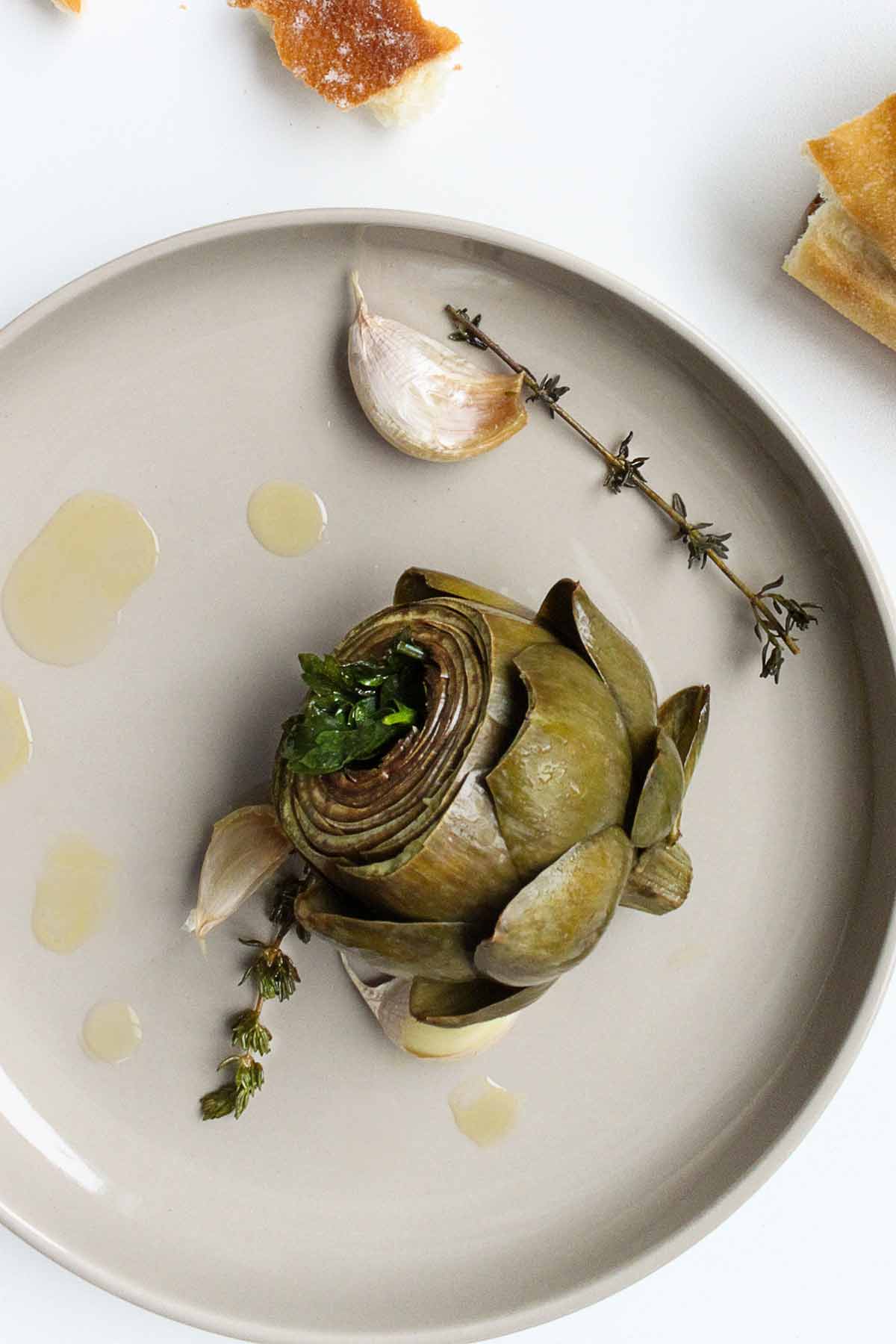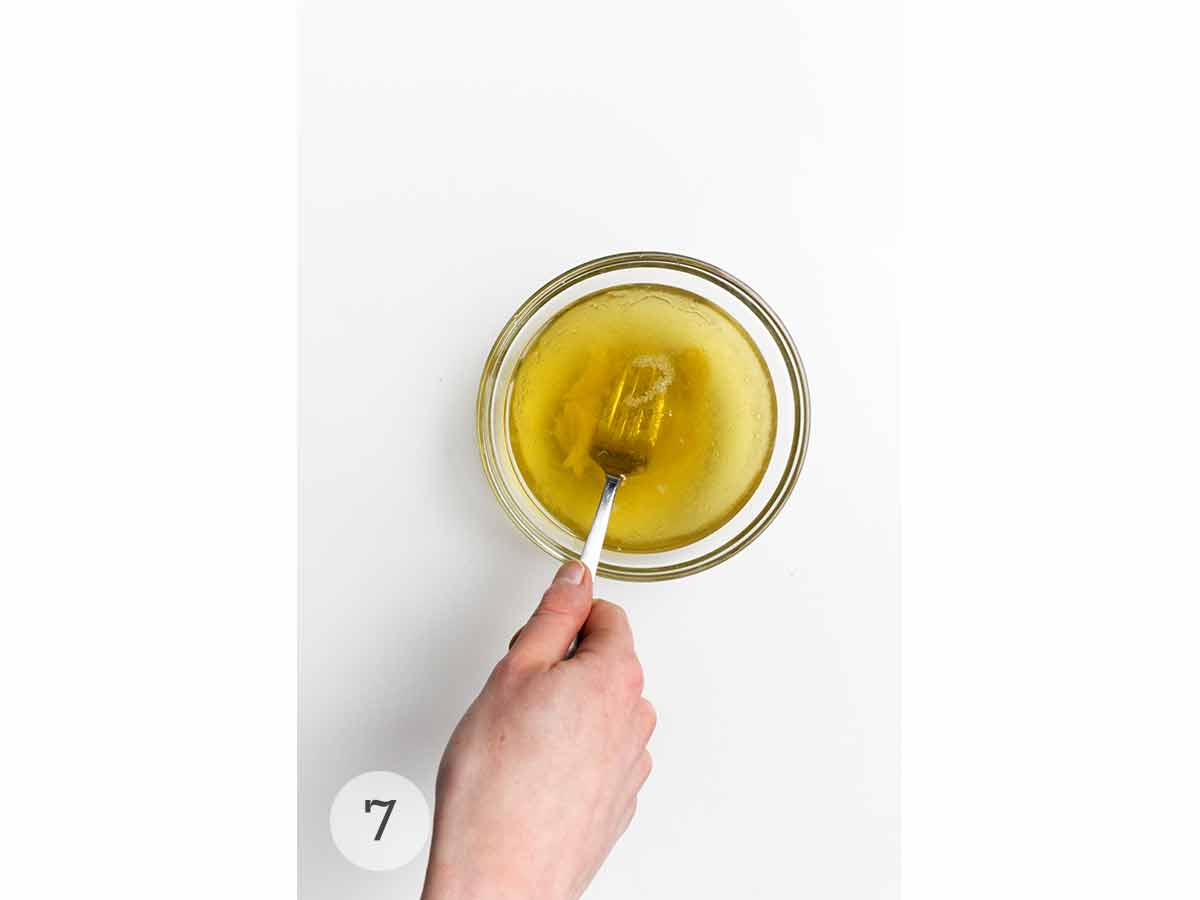
A profusion of artichokes in the markets is synonymous with spring in Rome. Although the Romans have many ways to cook up this bounty–called carciofi alla romana (Roman-style artichokes)–we’re fond of this slow braise, which infuses the artichokes with a subtle hint of garlic.–The Editors of Gourmet

Why Our Testers Loved This
There are a whole bunch of reasons our recipe testers loved these Italian artichokes. Sofia R. was delighted that “the recipe was very easy to follow, and the preparation was pretty fast.“
Kristin C. joined in with her comment, “A simple and rustic way to cook artichokes, resulting in a tender heart with outer leaves perfect for dipping.“
What You’ll Need to Make This

- Artichokes–Select medium-sized artichokes weighing 6 to 8 ounces each. Using similarly-sized chokes will ensure they are all cooked to the same tenderness.
- Olive oil--Use the best-quality olive oil you have for braising these artichokes, as the flavor of it will be noticeable in the finished dish.
- Crusty bread–Use a crusty artisan bread or baguette for dipping in the leftover braising juices.
How to Make This Recipe

- Halve the lemon and squeeze the juice into a bowl of cold water.
- Trim the tops off the artichokes and scoop out the fuzzy choke from the center. Store the prepared artichokes in the lemon water until you are ready to cook.

- Stuff the center of each artichoke with three parsley sprigs.
- Heat 1/4 cup olive oil in a large pot over medium heat. Add 1/4 cup water and arrange the artichokes in a single layer. Scatter over the garlic and thyme, and season with salt and pepper.

- Cover the pot and braise the artichokes, turning occasionally, until tender and browned in spots. Use a slotted spoon to transfer the artichokes, garlic, and thyme to a platter.
- Add 3/4 cup water to the pot. Bring to a simmer and cook, stirring up any browned bits, for 1 minute.

- Strain the pan juices into a medium bowl. Season with salt and add one tablespoon of oil. Squeeze in two garlic cloves and mash the garlic into the juices with a fork.
- Serve the artichokes with extra pan juices, garlic cloves, and crusty bread for dipping.
Common Questions
When standing at the farmers market or grocery store contemplating which prickly, thorny, pointed artichokes you should select, look for those whose leaves are tightly closed and form snug, compact heads. Pass over any whose leaves are splayed in all directions. The leaves themselves ought to be green; any tinges of purple are fine, but disregard any with brownish hues.
Pick up the artichoke and feel it. The veggie ought to feel heavy in your hand. And rest assured that this is one of those things that, as with many things in life, you come to know and learn and appreciate with experience.
For these Italian-style braised artichokes, you can pull off the outer leaves and dip them in the braising sauce. Pull the leaves through your teeth to remove the soft pulpy section at their base, then discard the remainder of the leaf. The soft center, or heart, is entirely edible and can also be dipped in the sauce.
Insert the tip of a sharp knife where the stem meets the leaves. When fully cooked, the knife should slide in easily, and the flesh of the artichoke should be tender.
Artichokes have two peak seasons, one from March until June and then again from September to October. They’re most abundant during the spring.
Carciofi can be a little tricky to pair with wine. This can be attributed to the presence of an organic acid known as cynarin, which plays tricks on your perception of taste and makes pretty much everything seem strangely sweet for a short while.
It’s a fluke that’s earned artichokes the term “wine sinners,” though that’s not to say you need to do penance and shun wine with your carciofi. You just need to choose it a little more carefully than usual.
A dry white wine typically does the trick, whether a Sauvignon blanc, a Chenin blanc, or a Vouvray. If you’d like to stick with something Italian, there’s the Villa Simone Frascati. It’s the classic white of the Lazio region, which surrounds Rome. It’s light, refreshing, and aromatic.
Helpful Tips
- If you find it tricky to scoop out the choke while keeping the artichoke intact, you can slice the artichokes lengthwise and scoop out the choke. If you do this, start checking your artichokes for doneness after 20 minutes.
- This recipe is suitable for dairy-free and vegan diets.

Write a Review
If you make this recipe, or any dish on LC, consider leaving a review, a star rating, and your best photo in the comments below. I love hearing from you.–David

Italian-Style Artichokes ~ Carciofi
Equipment
- 6- to 8-quart heavy pot wide enough to hold artichokes in a single layer (about 11 inches in diameter)
Ingredients
- 1 lemon, halved
- 6 medium (8 oz each) artichokes
- 18 flat-leaf parsley sprigs
- 1/4 cup olive oil
- 8 fresh thyme sprigs
- 1 head garlic, cloves separated and unpeeled
- 1 cup water
- 1 teaspoon salt
- 1/4 teaspoon black pepper
- 1 tablespoon extra-virgin olive oil
- Crusty bread for serving
Instructions
- Fill a large bowl with cold water and squeeze the lemon halves into the bowl.
- Working with 1 artichoke at a time, cut off and discard the top inch of the artichoke.
- Using your fingertips, gently pull or pry open the leaves to reveal the center of the artichoke. Using a spoon (or a melon baller or a pointy-tipped grapefruit spoon), scoop out any sharp leaves and the fuzzy choke from inside the artichoke.
☞ TESTER TIP: You’re looking, beneath all those pointy tips and fuzz, for what’s called the artichoke heart. If the stem of the artichoke is still attached, use a knife to trim it.
- Place the artichoke in the bowl of lemon water. Repeat with the remaining artichokes. (The trimmed artichokes can be kept chilled in lemon water for up to 8 hours.)
- Remove the artichokes from the water. Push 3 parsley sprigs into the center of each.
- Heat 1/4 cup olive oil in a pot over medium heat until it shimmers, then carefully add the artichokes, thyme sprigs, garlic, 1/4 cup water, 1/2 teaspoon salt, and the black pepper.
- Cover the pot and braise the artichokes, turning occasionally, until they’re browned in spots and the base of each artichoke–where the stem meets the leaves–is tender when pierced with a knife, about 35 minutes.
- Using a slotted spoon, remove the artichokes, thyme, and garlic to a platter. Add the remaining 3/4 cup water to the pot and bring to a boil. Cook over high heat, stirring and scraping up any brown bits, for 1 minute.
- Pour the deglazed pan juices (they will be dark) into a small bowl and stir in the extra-virgin olive oil and the remaining 1/2 teaspoon salt. Squeeze the pulp from 2 of the garlic cloves into the juices and mash them into the sauce using the tines of a fork.
- Divide the braised artichokes and, if desired, the remaining garlic cloves among 6 plates and drizzle with the sauce. The garlic cloves can be peeled and spread on crusty bread.
Notes
- Preparing the artichokes–If you find it tricky to scoop out the choke while keeping the artichoke intact, you can slice the artichokes lengthwise and scoop out the choke. If you do this, start checking your artichokes for doneness after 20 minutes.
- Dietary–This recipe is suitable for dairy-free and vegan diets.

Nutrition
Nutrition information is automatically calculated, so should only be used as an approximation.
Recipe Testers’ Reviews
I must say I love artichokes simply steamed and then eaten with melted butter and lemon juice, but these braised artichokes changed my mind.
It still keeps the true flavors of the artichokes intact yet brings them to a higher dimension. The recipe is very easy to follow, and the preparation is pretty fast. We all absolutely loved it, and the juices were perfect for eating with some bread.
As I was eating these Italian braised artichokes last night, I started ticking off friends in my mind who I should be sharing this meal with. I imagined us sitting at the table with a bottle of Prosecco, roasted garlicky chicken wings, and these artichokes.
We were eating everything with our hands, unabashedly scraping artichoke leaves with our teeth and eyeing the last few cloves of the braised garlic.
I haven’t had much success preparing artichokes any other way besides the old Italian-American standby—stuffed with breadcrumbs and steamed—that is, until I prepared these little babies. This recipe is insanely good, and I will braise artichokes forevermore.
I needed to add water throughout the cooking process. In the end, I added an additional 3/4 cup of water in 1/4-cup intervals when the pot threatened to run dry and scorch. Don’t add the additional water up front, as you’ll never deeply brown your garlic or artichokes, and those crispy brown bits are treasures.
Add a little salt into the heart cavity with the parsley. I also used baby artichokes, which surprisingly took the same amount of time to cook, yet I didn’t have to scoop out the choke during prep. Enjoy—this recipe is a true crowd-pleaser. I can’t wait to serve these to friends.
A simple and rustic way to cook artichokes, resulting in a tender heart with outer leaves perfect for dipping.
I found it easiest to cut the artichokes down the middle lengthwise and scoop out the fuzzy inedible part. Although I couldn’t stuff each one with the parsley stems, I still added herbs to the dish.
The sauce turned out beautifully, and instead of pouring it over the artichokes, I used it as a dipping sauce. This clean preparation allows this spring ingredient to shine at its best.
Never. I’ll never steam artichokes again after making these delicious slow-braise chokes instead.
When done, no dipping sauce is needed; this recipe covers a better way to cook the artichokes and how to use the cooking juices as the base for the sauce.
This would make a lovely appetizer or first course, especially if those nice soft cloves of garlic were presented with crusty bread alongside the braised artichokes.
I couldn’t locate medium-sized artichokes that were a 1/2 pound each. The closest I could find was 1/3 pound each, so I scaled down appropriately for this change, and everything worked just fine.
I like that this Italian recipe specifies olive oil for the cooking and extra-virgin olive oil for the sauce. Could you use just one or the other? Absolutely, yes, but this is the correct use for each.
I was concerned I had dug out too much of the inside of the artichoke, as I scooped quite a bit, but it ended up being just right. I did use a grapefruit spoon, as opposed to a melon baller or a regular spoon. It scooped just fine, but my grapefruit spoon is now misshapen.
When the instructions detailed trimming the stem, I believe it meant “peel,” which made sense to me then and is what I did. I loved that it made a vegetarian pan sauce, and it was just the perfect amount!
This is the third artichoke recipe in a row that I’ve tested here: the first was the Rigatoni with Artichokes, Garlic, and Olives Recipe, and the second was for fried artichokes. I’d make all three again, each suitable for different meals or situations and all definitely worthy endeavors.



















This looks delicious, thanks for posting and I look forward to trying this technique. A couple of tips I find helpful is to use a serrated bread knife to cut the chokes. Melon baller also works well, needle nose pliers come in handy for removing those extra stubborn feathery chokes. Patience is your friend here. Happy cooking!
Thank you for all the great tips, lowandslow. Please let us know how they turn out.
This recipe originally appeared in either Bon Appetit or Gourmet, and I make it often. Delish, as the other comments have noted. If you are pressed for time, here is an even simpler but also delicious way to prepare artichokes: Cut them in half and scoop out choke. Melt 2 Tbsp. of butter and over med-low heat brown artichokes, cut side down, until nice and brown (5 min or so). Turn over and brown 2 or 3 more minutes. Add about 2/3 c. good quality chicken stock (or a bit more if you have a a lot of artichokes). Slowly braise about 20-30 min depending on size of artichokes. When artichokes are about done, grate in a bit of lemon zest and add a squeeze of lemon juice. The reduced, lemony broth makes a great sauce. It sounds too simple but it is really good!
Yes, Marion, this recipe originally appeared in the late Gourmet magazine. We were reacquainted with it when it appeared in the handy collection of Italian recipes from the magazine that we note above, just beneath the photo. And thank you, I love the sound of your alternate recipe—simple and lovely.
OK with the artichokes already…how’s David? Is he using a cane? crutches? Are you on the ship?
My dear Stu, I’m okay. Thanks. I was shaken up quite a bit. As The One likes to say, the only wounds I’m licking are those to my pride.
Right now I’m on Celebrity Cruise’s Constellation somewhere off the coast of France. I hope to use this day at sea to catch up on all my London dispatches.